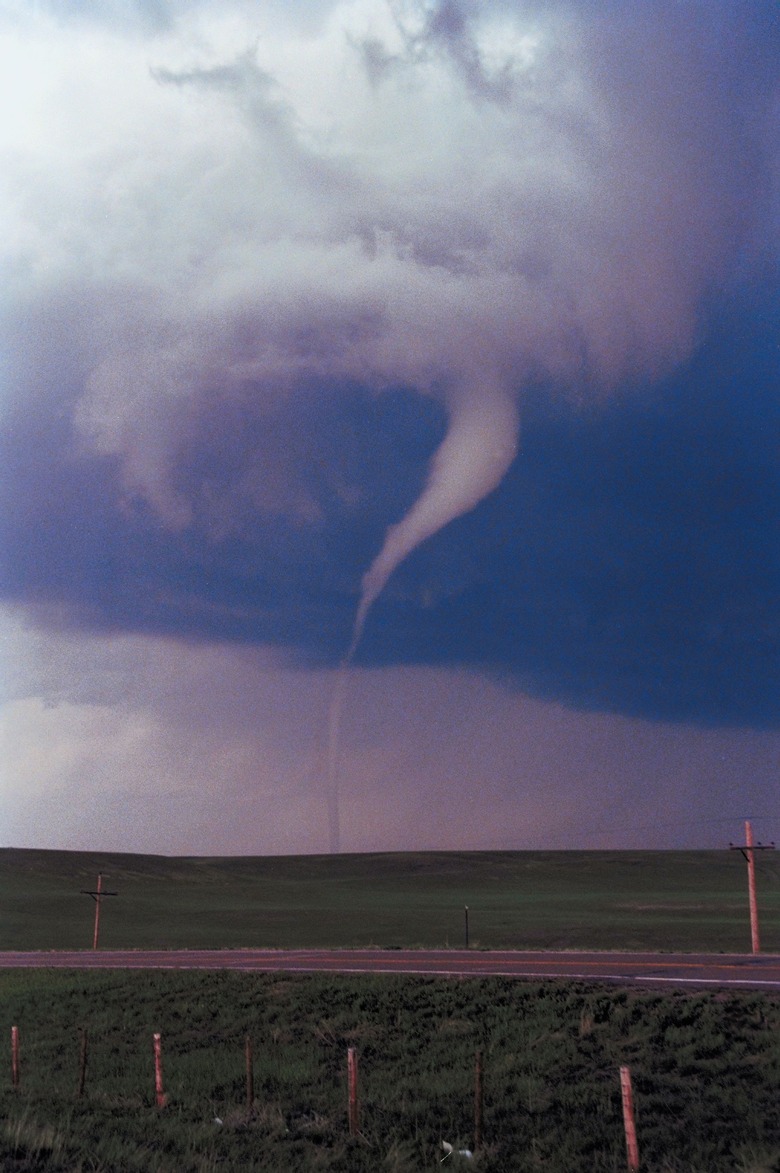The Levels Of Tornadoes
Powerful and hard to predict, tornadoes can form quickly, cause widespread death and destruction and then vanish minutes later. To track and classify these storms, the National Weather Service bases tornado ratings on tornado wind speed and damage patterns to determine the intensity of the tornado. The Enhanced Fujita Scale classifies storms from Category 0 to Category 5, with the top category reserved for only the most devastating and catastrophic storms.
Enhanced Fujita Scale
Enhanced Fujita Scale
The Enhanced Fujita Scale contains six categories. The weakest, EF0 tornadoes, involve sustained winds between 105 to 137 kilometers per hour (65 to 85 mph). EF1 tornadoes have wind speeds up to 178 kilometers per hour (110 mph), while those classified EF2 reach speeds of 218 kilometers per hour (135 mph). EF3 tornadoes contain winds up to 266 kilometers per hour (165 mph), and EF4 tornadoes may range up to 322 kilometers per hour (200 mph). Anything beyond these speeds is an EF5 tornado and represents an extremely powerful and dangerous storm.
Strong Storms
Strong Storms
The most powerful tornadoes are also the rarest. EF4 and EF5 tornadoes represent only about 1 percent of all tornadoes recorded, but they cause two-thirds of the deaths attributed to tornadoes each year. Due to concerns about citizens ignoring repeated tornado warnings, the National Weather Service has adopted new and more graphic language in its tornado bulletins regarding these dangerous storms. Patterned after the language used in the warnings before Hurricane Katrina, these new warnings replace dry estimates of wind speed and movement with graphic explanations of the type of damage the storms are capable of producing.
Measurement Difficulties
Measurement Difficulties
While the Enhanced Fujita Scale uses wind speed to categorize tornadoes, meteorologists have difficulty getting an accurate wind measurement of a storm in progress. Tornadoes tend to appear and disappear quickly, they can take erratic paths along the ground, and weather stations close enough to measure accurate wind speeds may fall victim to the funnel cloud. For this reason, meteorologists classify most tornadoes in the days following the storm, using observations of the damage and path of the tornado to estimate wind speeds.
Damage Estimates
Damage Estimates
To facilitate tornado classification, the Enhanced Fujita Scale includes 28 damage estimate models, each based on a common structure or item a tornado might strike. For instance, if a hardwood tree shows small broken branches, this suggests wind speeds ranging from 97 to 116 kilometers per hour (60 to 72 mph). On the other hand, if the storm completely stripped the tree of bark, it would indicate winds of 230 to 269 kilometers per hour (143 to 167 mph). By considering multiple damage samples along the path of the tornado, meteorologists can build a reasonable picture of its strength even days after the fact.
References
- NOAA Storm Prediction Center: Enhanced F Scale for Tornado Damage
- NOAA Storm Prediction Center: A Recommendation for an Enhanced Fujita Scale (EF-Scale)
- Meteorology: Understanding the Atmosphere (3rd edition); S.A. Ackerman, J.A. Knox
- NOAA National Climatic Data Center: The Enhanced Fujita Tornado Scale
Cite This Article
MLA
Kazmeyer, Milton. "The Levels Of Tornadoes" sciencing.com, https://www.sciencing.com/levels-tornadoes-4910/. 7 August 2018.
APA
Kazmeyer, Milton. (2018, August 7). The Levels Of Tornadoes. sciencing.com. Retrieved from https://www.sciencing.com/levels-tornadoes-4910/
Chicago
Kazmeyer, Milton. The Levels Of Tornadoes last modified March 24, 2022. https://www.sciencing.com/levels-tornadoes-4910/
